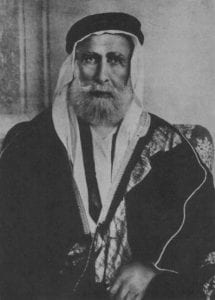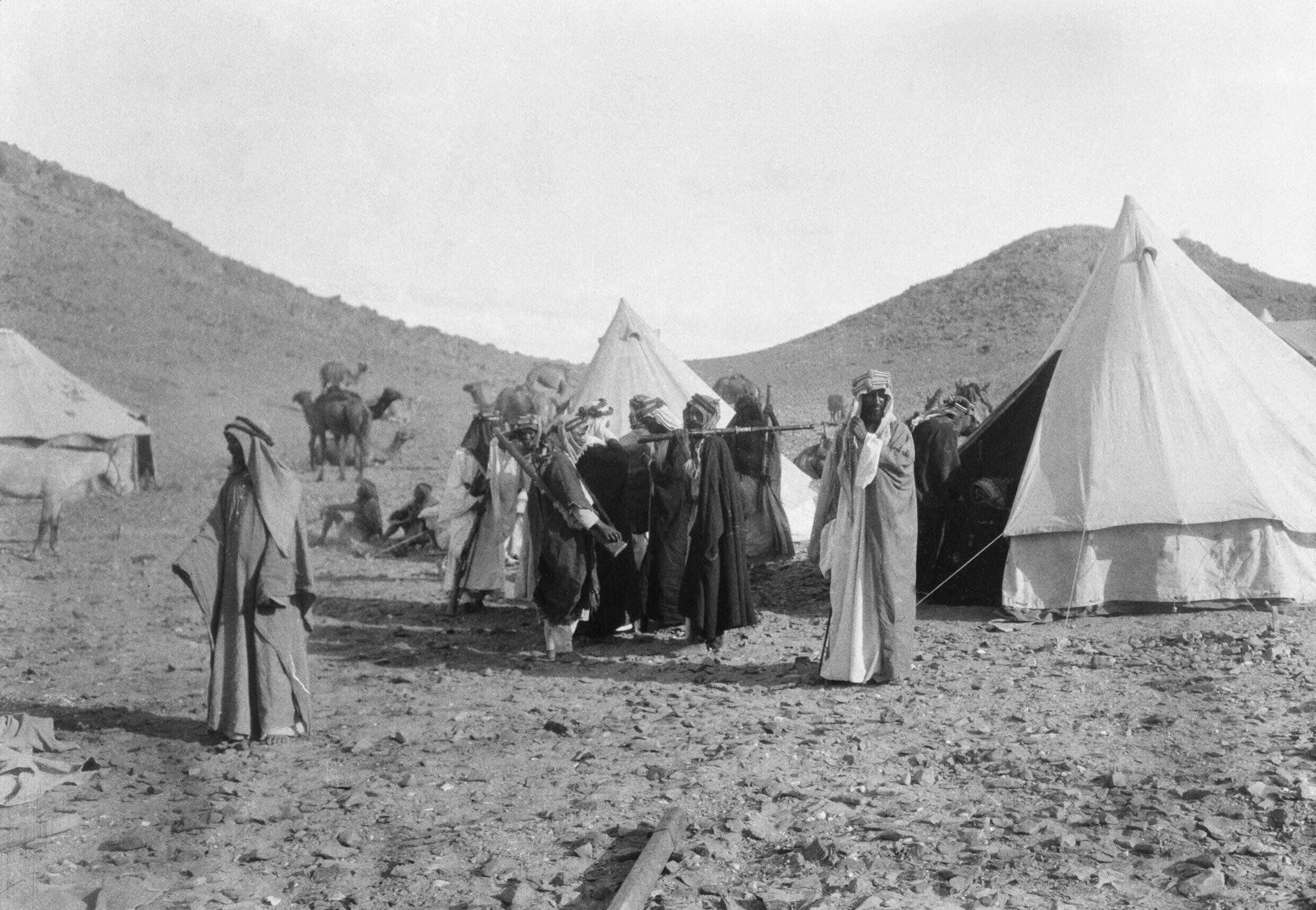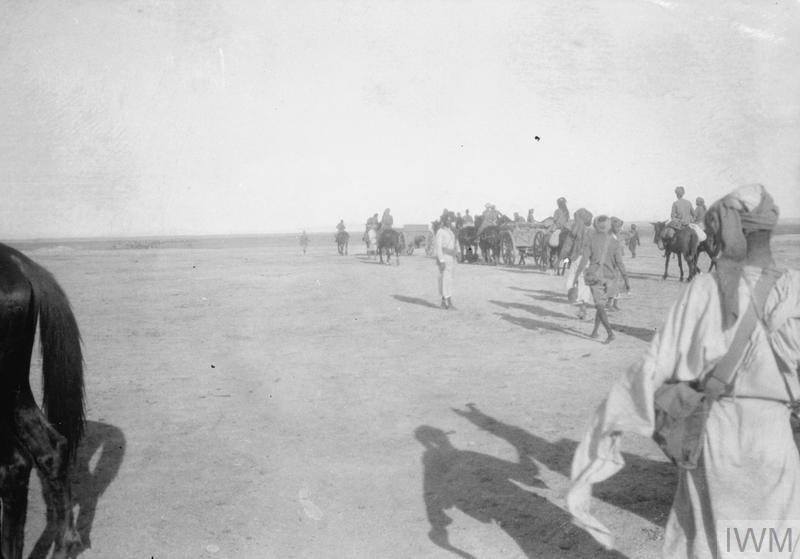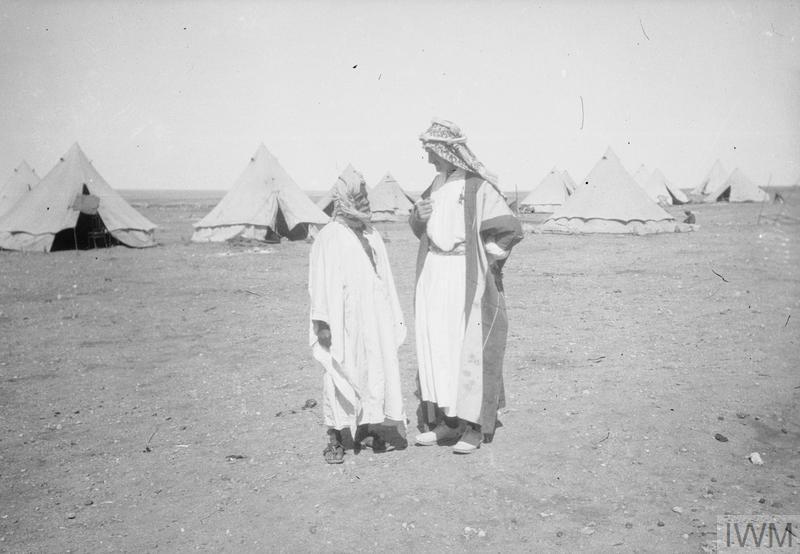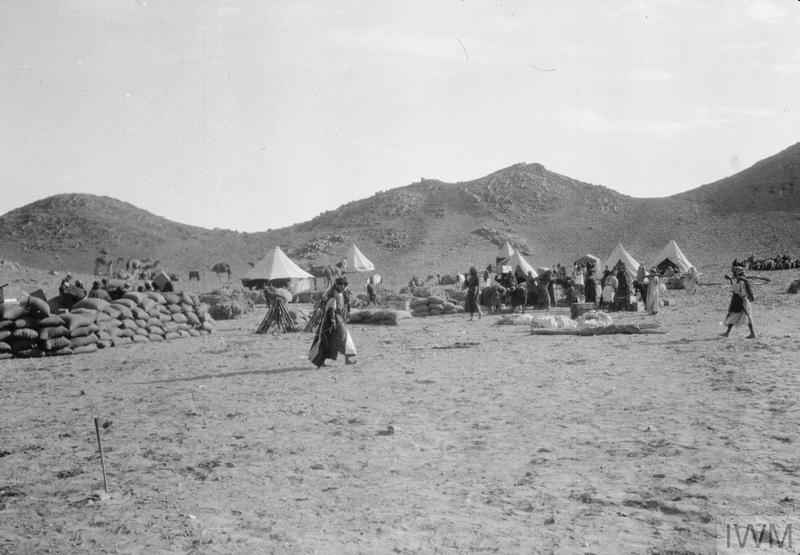< Egypt, Palestine, Syria & Arabia
The Arab Revolt
From the British perspective, the Arab Revolt was a relatively minor part of the war in the Middle East, involving just a small number of British military liaison officers supporting a loose army of disparate tribes. However the romance of the white-robed, camel-mounted warriors led by the enigmatic ‘Lawrence of Arabia’, coupled with a political legacy which still resonates today make this one of the best known campaigns of the war away from the Western Front.
Ultimately, the Arab Revolt epitomised the jockeying to fill the power vacuum which would ensue if the Ottoman Empire was defeated. Before the war there were strong signs that the Empire was on the wane – defeat in the Balkans in 1912 – 1913, the loss of control of Egypt, Libya and Tunisia, and losses to Russia in the Caucasus. When war began, the Entente powers circled the ‘sick man of Europe’, eyeing their chance to profit from its demise.
Second class citizens in a Turkish Empire
However it was the Arabs who had most to gain in the Middle East. For centuries the Ottoman Empire had been tolerant and cosmopolitan, but following the 1908 coup by the ‘Young Turks’ the government became increasingly pro-Turkish. As ‘second class citizens’ in this Turkish-controlled Empire, the Arabs saw opportunities for autonomy and power in the whole of the Arabian lands in the Middle East – modern-day Yemen, Saudi Arabia, Jordan, Palestine, Lebanon, Syria, Iraq and the Gulf States. The Young Turks were suspicious of Arab nationalism and attempted to control their ambitions by centralising power in Constantinople.
The Hejaz Railway, recently constructed to help make pilgrimages to the holy sites of Mecca and Medina quicker and less dangerous, could also be used to transport troops into Arabia to put down uprisings. It was to become a focal point of the whole Arab Revolt.
Political and economic power was a major factor behind the revolt, but religion was also important. The Ottoman sultan was the caliph, the head of Islam, yet Sharif Hussein bin Ali was Emir of Mecca, ruler of the holiest site in Islam. For the Ottomans, losing control of Mecca would be a blow to their centuries-old role as leader and protector of Islam. Muslims were not limited to the Ottoman lands, so gaining the support of the faithful from far and wide was important for both parties.
Why did the Arabs side with Britain?
Sharif Hussein could have chosen to side with the Ottomans against Britain. In 1916 the British had lost to the Ottomans at Gallipoli and were being beaten back in Mesopotamia – they were by no means bound to win the war. Had the Arabs sided with the Ottomans the British would have had yet another setback, and may have lost control of Egypt, the Suez Canal, the Red Sea and with it access to India.
Britain was alarmed at the possibility of losing control of its sea route to India and early in the war had started secret negotiations with the Hussein family (the Hashemite dynasty). Even before the outbreak of war they had had discussions with Hussein about guarantees should the Ottoman Empire side with Germany. When this happened, negotiations were stepped up between the Arabs and Sir Henry McMahon, High Commissioner of Egypt, in what became known as the ‘Hussein-McMahon Correspondence’. Eventually McMahon agreed to ‘recognise and support the independence of the Arabs in all the regions within the limits demanded by the Sharif of Mecca’ but excluded the Gulf States (already controlled by Britain) and parts of Syria (already earmarked for French control after the war as a result of the secret Sykes-Picot Agreement) and demanded ‘special administrative arrangements’ in the Ottoman vilayets of Basra and Baghdad in Mesopotamia. Sharif Hussein negotiated time limits to British control in Syria and Mesopotamia before concluding the agreement in March 1916. In the two secret agreements – Sykes-Picot and Hussein-McMahon – Britain was hedging its bets, attempting to plan for a possible post-war future while securing present support. In the end, it would be impossible for Britain to honour all its promises, so both these controversial agreements have led to accusations of double-dealing which persist to this day.
Ultimately it was the actions of the Ottomans which drove the Arabs over to the British offer. Even before the war, Sharif Hussein’s relations with the Young Turk government had been strained to breaking point. Now, the Ottoman government’s response to Arab nationalism was brutal. In Syria, leading Arab nationalists were rounded up and executed and 50,000 Arab civilians suspected of having nationalist leanings were exiled to Anatolia, with disastrous effects on agriculture. Added to this, in 1915 – 1916 a plague of locusts ruined crops which were already being depleted through requisitioning to feed the Ottoman army. A famine ensued and was to affect the area for the rest of the war, with up to 500,000 deaths estimated by 1918. Furthermore, the British naval blockade of Syria’s Mediterranean ports meant that humanitarian aid could not get through.
The revolt starts with a single gunshot . . .
With Britain on the back foot after Gallipoli and the setbacks in Mesopotamia, and with Arab nationalism subdued after the Ottoman clampdown, it looked like both sides needed each other, and Sharif Hussein decided to accept British offers of arms and support. He started the Arab Revolt on 10 June 1916 by firing one symbolic shot towards the Ottoman garrison in Mecca.
The initial success of the Revolt in the Hejaz region was striking: by September 1916, assisted by Bedouin horsemen and British naval and air support, they had taken the Red Sea ports of Jeddah, Rabigh and Yanbu. They had also taken Mecca and Ta’if and had captured 6000 Ottoman prisoners. Sharif Hussein pronounced himself ‘King of the Arabs’ and his sons took the title of ‘Emir’.
. . . but then stalls
However there were problems. Sharif Hussein had hoped that Arab officers in the Ottoman army would join the revolt but many remained loyal. Meanwhile many in the wider Muslim world opposed the Revolt, especially in India where the All-India Muslim League passed a resolution condemning it and calling for jihad.
Things were not going well in the Hejaz either, after the initial success. Keeping control of the conquered cities was almost impossible, especially when the Bedouin tribesmen slipped away into the desert after the early excitement. The Ottomans planned a counterattack in August 1916.
The British were always reluctant to send troops to support the Arab Revolt, out of fear that Indian Muslims would revolt. Their solution to the threat on an Ottoman counterattack was to recruit Ottoman Arab nationalists held in their prisoner of war camps in Egypt and Mesopotamia. These were to form a core of regular soldiers alongside the many thousands of irregulars. However the numbers actually signing up were disappointing, so the British sent a small contingent of 960 Muslim Egyptian gunners to assist the Arabs, albeit much against their will. Even this would not be enough so a new approach was needed.
Enter ‘Lawrence of Arabia’
This is where T E Lawrence stepped in. In October 1916 he was sent to the Hejaz to meet Sharif Hussein’s sons, initially to judge whether or not it would be worth sending in British troops. Lawrence was an intelligence officer and spoke fluent Arabic, having worked as an archaeologist in Syria before the war. Arriving at the camp of Emir Faisal, third son of Sharif Hussein, Lawrence saw a despondent and demoralised army. Photos which he took during his time with the Arab army give a real insight into what life was like in the Arab camp.
Lawrence concluded that troops on the ground would be less useful to the Revolt than gold (to pay for support from the Bedouin), technical advice and air support. The British would pay for a guerrilla campaign.
This was not a moment too soon. The Ottomans counterattacked in December 1916 and forced the Arabs back, threatening the port of Yanbu. However their supply lines were vulnerable – basically limited to a single railway line – and when this was attacked by Bedouin tribesmen supported by British planes, the Ottoman advance faltered and they turned back.
Arabs take the Hejaz
10,000 Ottoman troops remained isolated in Medina but the new policy was to cut them off from the rest of their army and continue with the guerrilla war, raiding Ottoman posts, attacking the Hejaz Railway and gradually moving up the Red Sea coast with the support of British naval and air power. By the end of 1916 – after £1 million of British gold had been handed over – the Hejaz region was effectively under Arab control.
The Arab Revolt did not end there, but from 1917 it became part of the wider Palestine Campaign, harrying the Ottoman army from the east as the main Egyptian Expeditionary Force drove up the Mediterranean coast. This hadn’t been the original British strategy, but the Arabs’ success in the Hejaz gave them the opportunity to attack the Ottoman army from two fronts. The British war cabinet wanted results and on 27 June 1917 General Edmund Allenby was given command of the Egyptian Expeditionary Force with instructions to drive the Ottomans back and take Jerusalem. It was an enormous boost to British morale when he achieved this before Christmas 1917.
The British continued to supply the Arab army: 30,000 rifles with 15 million rounds of ammunition; Rolls Royce armoured cars and more gold and grain. They also built landing strips in the desert so that the Royal Flying Corps could bomb the Hejaz Railway.
Across the desert to Aqaba
There was one more obstacle for the Arab advance: the port of Aqaba on the border with Palestine. This was well defended towards the sea but not on its landward side where any attacker would have to cross miles of desert first. The capture of this city on 6 July 1917 by galloping Bedouin tribesmen led by the charismatic ‘Lawrence of Arabia’ is one of the iconic moments of David Lean’s romantic film. The whole of the Red Sea was now under Allied control and it was now possible for the two armies to work together.
Bolsheviks let the cat out of the bag
Suddenly, however, events far away cast their shadow on the Arabs’ war against their Ottoman oppressors. After the Russian Revolution in November 1917 the Bolsheviks set out to discredit the Tsar’s regime and leaked the details of the Sykes-Picot agreement to the world. The Ottomans used the news to taunt the Arabs, saying that they had been duped by the double-dealing British. However, although Sharif Hussein demanded an explanation, he knew that it was too late to change sides now.
During the winter of 1917 – 1918 the Arab army moved north along the line of the Hejaz Railway, avoiding the well-defended Ottoman position at Ma’an. All the time, though, the well-disciplined Ottoman army was able to repel advances by the Arabs, so little progress was made. Added to this, the British campaign in Palestine had ground to a halt, largely due to the German Spring Offensive on the Western Front, which led to Allenby being ordered to send 60,000 of his troops back to Europe.
Devious techniques
Everything changed in September 1918, when Allenby’s skill as a general led to the final denouement. Through the summer he had led the Ottomans to believe that the breakthrough would be on the Arabs’ front, to the east of the River Jordan. He used a range of devious techniques to achieve this. Cavalry groups were sent to the desert where they moved north by day and then fell back at night, before moving north again the next day to give the impression of a build-up. Bridges were built. False radio signals were sent out. 15,000 model horses were made of canvas and wood.
On 19 September 1918 Allenby launched his main attack, at Jaffa on the Mediterranean coast, taking the Ottomans completely by surprise. By the end of the month, the Allies had captured Damascus. Soon after, the Ottomans capitulated.
Meanwhile T E Lawrence led the Arabs on more guerrilla attacks on the Hejaz Railway, forcing the Ottomans to divert troops to defend it. As the Arabs gained in confidence, there were massacres and atrocities. One so called ‘retaliation’ was carried out under the orders of Lawrence himself: ‘we killed and killed, even blowing in the heads of the fallen and of the animals’. Later he wrote that he was ‘continually and bitterly ashamed’ of his role in the Arab Revolt.
Empty promises

Lawrence of Arabia’s map, presented to the Eastern Committee of the War Cabinet in November 1918 (Source: Wikipedia)
All along, the Arabs had sided with the British on the promise of independence after the war. T E Lawrence drew a map for the British war cabinet which outlines the Arabs’ expectations. However in the following months and years all their hopes were dashed, as Britain and France moved to secure their own interests in the Middle East. As far as the Arabs were concerned, imperial rule continued, albeit under different rulers.
Allenby informed Faisal Hussein that the British would control Palestine (in order to oversee the implementation of the Balfour Declaration) and Mesopotamia. The French would control Lebanon. All Arab lands would be brought under ‘Allied Occupied Enemy Territory Administration’. Where there was no direct rule, the British and French would govern territories through a system of mandates – temporary government for a period before representative national governments took over.
Arab resentment towards the West

The Arabian Commission to the Peace Conference at Versailles and its advisors. Feisal front, TEL 3rd from right 22.1.1919 © IWM (Q55581)
Unsurprisingly, these political arrangements were extremely unpopular with the Arabs. At the very least, they demanded independent states in Syria and the Hejaz. When Faisal Hussein established himself in Damascus as king of Syria the French despatched a force of colonial troops and sent Faisal into exile. His father Sharif Hussein remained as king of the Hejaz but refused to have anything further to do with the British and in 1925 his country fell to the up-and-coming Saud family. Faisal and his brother Abdullah were eventually installed as kings of Iraq and Transjordan respectively but these were nominal roles only as the British ruled the countries under the mandate system.
The Arab Revolt had contributed to the defeat of the Ottoman Empire in the Middle East yet, far from being rewarded for their support, they were sidelined after the war. It is not surprising that Arabs continue to distrust the West to this day.
Text by AFTWF, edited by Professor Eugene Rogan, Director of the Middle East Centre at St Antony’s College, University of Oxford.




